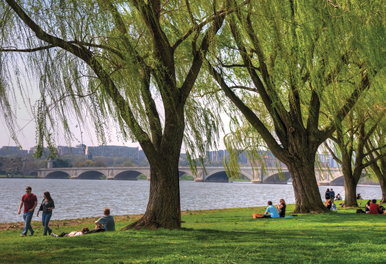
The District has for the last three years topped the Trust for Public Land’s (TPL) ParkScore ratings, boasting the best urban park system in the country, with nearly every Washingtonian living within a 10-minute walk of a park.
About one-fifth of DC—9,500 acres—is parkland. Ninety percent of that green space, including Rock Creek Park and the National Mall, is under the jurisdiction of the National Park Service. The city manages the other 10 percent: 851 acres of pocket parks, playgrounds, and picnic spots sprinkled across eight wards.
In a city where 10 percent of children live with asthma, parks improve air quality, as trees and plants absorb carbon dioxide and convert it to oxygen. Parks reduce runoff and pollutants in stormwater and provide spaces for people to tend to their physical and mental well-being and gather in community.
However, in DC, the grass is sometimes greener on the other side of the city.
Roads and highways, including Interstate 295, which slices through Anacostia, can cut off residents’ safe access to green space, and parks in denser neighborhoods with multifamily housing often have less tree canopy. According to a 2021 report from TPL, parks serving mostly people of color are half as large and five times as crowded as those in majority White communities.
Outdoor spaces in predominantly Black neighborhoods like Wards 7 and 8 also aren’t as well kept or equipped as those in Whiter, wealthier parts of the city, according to a 2023 report from the Sumner M. Redstone Global Center for Prevention and Wellness. Dozens of parks don’t have benches, modern playground equipment, or, in the case of forested parks east of the Anacostia, trails.
“Equitable access to parks is crucial because green spaces are not just amenities but essential components of urban health infrastructure,” says Julie Gonzalez, environmental justice postdoctoral fellow, AU’s Center for Environment, Community, and Equity. “Parks offer physical and mental health benefits, helping to mitigate stress, improve cardiovascular health, and foster community cohesion. When parks lack basic amenities or safe trails, particularly in underserved areas, it deepens existing health disparities, making this an issue of environmental justice.”
AU community members are exploring the issue of park equity from all angles. Meet a few of them here.
“Parks are where we relax, recreate, and connect with others in our communities. We must ensure that all DC residents have equal access to quality green spaces. We also need to make sure the upgrading of green spaces does not lead to gentrification by providing adequate affordable housing near parks and other high-demand locations.”
—Derek Hyra, founding director of AU’s Metropolitan Policy Center
“A park not only cools its visitors, but it also cools the nearby residents—even in the midday heat. Large parks built on remnant natural areas have the capacity to cool the air in a way that a similar amount of tree canopy distributed more widely does not. Inviting parks are also a vehicle for social cohesion and promote improved health via reduced air pollution, less noise, and the simple psychological benefit of being among live green plants.”
—Michael Alonzo, environmental science professor, whose research focuses on urban trees
“Access to nature is a human right, but far too many communities face barriers preventing them from experiencing the benefits of parks and green spaces. Whether it’s a lack of close-to-home natural areas, the cost of transportation, or extreme heat caused by climate change, low-income communities are suffering from the nature equity gap.”
—Jackie Ostfeld, CAS/MA ’06, director of the Sierra Club’s Outdoors for All campaign and founder and chair of the Outdoors Alliance for Kids
“This dog park is not just a recreational space; it’s part of our commitment to equity and accessibility.”
—DC mayor Muriel Bowser, SPA/MPP ’00, at the May 10 opening of the Texas Avenue Dog Park in Ward 7—the first one east of the Anacostia River
“As we know from research and from many of our own lives, parks and playgrounds are the heartbeat of a happy, active childhood. The reality—one that we cannot accept—is that race and economic status continue to determine whether children have safe, quality spaces to play.”
—Roopa Purohit, SOC/BA ’04, director of partnership development, KABOOM!, which has built or improved 17,000 playgrounds over the last 25 years and recently partnered with Prince George’s County, Maryland, to update and replace some of its 245 playgrounds